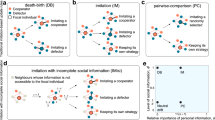Abstract
The discussion given by N. Rashevsky (1949) on the effect of imitation in the mathematical biology of social behavior is generalized by assuming the distributions involved to be normal rather than Laplace distributions, and also by showing how most of the results can be derived without assuming any specific form for the distributions. In particular, it is demonstrated that it is possible, in a sufficiently large population, to have a stable behavior pattern which is quite independent of the desires of the population or of their inherent pattern of response.
Similar content being viewed by others
Literature
Landahl, H. D. 1938. “A Contribution to the Mathematical Biophysics of Psychophysical Discrimination.”Psychometrika,3, 107–125.
Rashevsky, N. 1948.Mathematical Biophysics. Revised Edition. Chicago: University of Chicago Press.
— 1949. “Mathematical Biology of Social Behavior: III.”Bull. Math. Biophysics,11, 255–271.
Rosser, J. Barkley. 1948. Theory and Application of\(\int_0^z {e^{ - x^2 } } dx and \int_0^z {e^{ - p^2 y^2 } } dy \int_0^y {e^{ - x^2 } } dx,\) p. 19. Brooklyn: Maplton House.
Author information
Authors and Affiliations
Rights and permissions
About this article
Cite this article
Landau, H.G. Note on the effect of imitation in social behavior. Bulletin of Mathematical Biophysics 12, 221–235 (1950). https://doi.org/10.1007/BF02478322
Issue Date:
DOI: https://doi.org/10.1007/BF02478322




